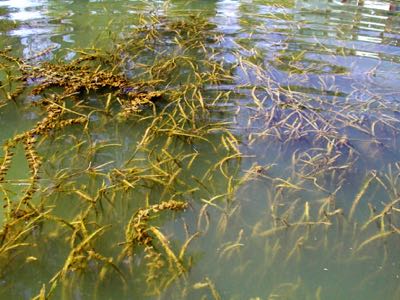Eurasian Watermilfoil
 Eurasian watermilfoil (Myriophyllum spicatum) was introduced to the U.S. from Europe in the late 1800s and has been a dominant species in Chesapeake Bay since the 1950s.
Eurasian watermilfoil (Myriophyllum spicatum) was introduced to the U.S. from Europe in the late 1800s and has been a dominant species in Chesapeake Bay since the 1950s.
Description
M. spicatum features feathery leaves arranged in whorls around the stem. It can form very dense mats of vegetation on the water surface.
Salinity Range
M. spicatum is a freshwater species that reaches greatest abundance in areas with very low or no salinity.
Reproduction & Growth
M. spicatum can reproduce through flowering and seed formation, fragmentation, rhizome growth, and bud formation. It is a "boom-or-bust" species that undergoes periods of explosive growth followed by declines, both in the Chesapeake Bay and elsewhere.
Distribution
M. spicatum occurs throughout the Old World and as a non-native in North America. It is absent from Australasia. It occurs in lakes, rivers, streams, canals and ditches, and prefers water with high levels of dissolved nutrients, high pH, and abundant organic matter. Today it is a persistent component of many freshwater seagrass beds, especially in the Potomac River and upper bay where it grows in protected waters. It has not been observed in the York River system as yet. Biomass can be high, especially in regions of nutrient enrichment.
Benefits
Although an introduced species that has been subject to extensive weed-control actions, especially in ponds and reservoirs, M. spicatum is an important component of the diet of many waterfowl species.
Threats
M. spicatum prefers water with high dissolved inorganic carbon, nitrate, nitrite, and pH, and in hydrosoil with high phosphate and organic matter contents.
Visit the IUCN page for range maps, conservation status, and other details.

